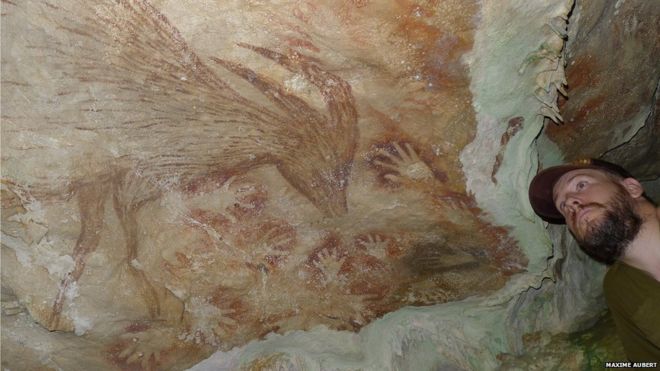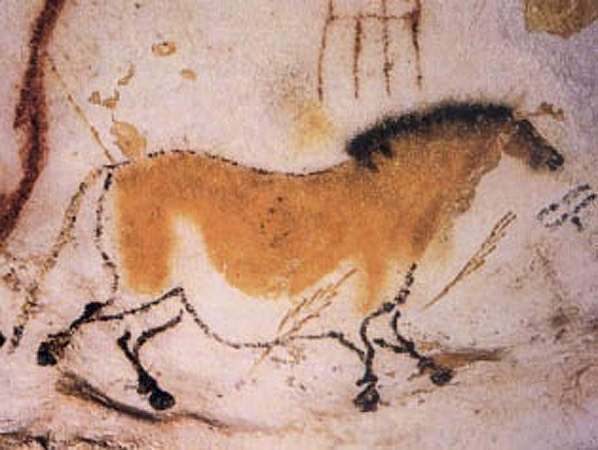Assignment One
Our Earliest Records & Migration Theories
Deadline, As announced, 80 points
|
Click here to go back to the Images of horses run through earlier images of giant aurochs at Lascaux.
Recently discovered ancient cave art in Indonesia.
|
How did humans come to populate the planet? What does the earliest artwork currently known tell us about the people who created it? What do we know or surmise about ancient technologies?
Lascaux Artwork
Description There is an old saying that a picture is worth a thousand words. The earliest records we currently have from ancient people are in the form of artwork. The most famous symbols and pictures of animals likely found at the time of these artists cover the walls at the caves in Lascaux, France, Altamira, Spain, the Chauvet Cave in France. The pictures show an earlier time, before the climate of Europe cooled. They show amazing attention to detail and artistic elements that would remain much less used for thousands of years. After touring Lascaux, the artist Pablo Picasso is famously quoted as saying, "We have invented nothing." In other words, he was saying that art had not improved in the 15,000 years since the artwork at Lascaux was created. And yet, early art is being discovered around the world. At this point it's probably a good idea to tell you I have studied history a lot - for a long time. I have come to a super important conclusion, and this is it - our knowledge of ancient history is continually changing. Views that are rock-solid and widely accepted as absolute fact right now can change. In part, this is because new discoveries are frequently being made all around the world. Another strong factor in our changing views of world history centers around our increasingly strong use of technology in finding new information and details from ancient artifacts and skeletal remains. If you doubt what I say about this ever-developing view of ancient man, I offer you just a few examples of finds and theories from and about ancient people that are now widely accepted and studied, but have developed since I was first in college. (That was about the time we invented fire.) Consider the following:
So, what does any of this mean? Simply this - I think it's a very good idea to remember that the timelines, graphs, and illustrations of how ancient people lived and moved are going to change. In many cases, the views we historians hold take decades to change, even when new discoveries come to light. It also continually amazes me that discoveries almost always show ancient people to be far more migratory and far more technologically advanced than previously thought. For now, please remember that things change and that studying pre history is a lot like putting together a jigsaw puzzle with many of the pieces absent or on which the patterns are oftern changing.
Objectives During this lesson, students will evaluate criteria used in the more popular theories about human migration. During this lesson, students will compare current and past theories about early artwork, what it may have meant at the time and what we can infer about the people who left it. Essential questions What characterizes modern man? How did people come to populate the planet? Why did people develop symbolic representational systems? How does that influence us today? How have our views of ancient technology changed the ways in which we study prehistory? Special instructions You will select one of the questions listed below. Then you will apply that question to one of the topics listed in the links under online files at the right side of this page. Please note that not all questions fit all topics, and some will have more detailed answers in one are than another. That's OK. Your job is to identify what early research led scientists to hypothesize about your chosen topics and identify how those hypotheses may, or may not, have changed over the years. If you choose to complete this assignment individually you need to complete an essay of a four or five paragraphs that addresses the question, or an equivalent presentation - you chose. If you choose to work with a group you will need to complete an essay of seven or eight paragraphs, or an equivalent presentation. Like the individual assignment, you will need to address the question you chose. Groups may never exceeed three members. You will need to share your work with your classmates. This could be discussing your essay, a slide show - a poster, you name it. You need to send me to what you share with the class. If it is not digital, take a picture and send the file to me.
Questions >>
Group names, topics, and selected questions. First Hour
Fifth Hour
|
Links Printed files There is no printed document for this assignment. Refer to the instructions. Media files To view the PowerPoint about problems in history, click here. To view the PDF file about archeological periods, click here. Online files How did people come to America? Ancient teeth in China challenge earlier theories. Similarities and differences between Neanderthals and modern humans More information about ancient cave art in Indonesia Neanderthal Mom, Homo Sapien Dad? What are we learning about the Denisovans? What happened to the Neanderthals? Here is one approach. When did humans leave Africa? New evidence in Arabia may challenge old theories. Prehistoric cave art suggests highly complex use of astronomy. Massive prehistoric malachite (copper) mines in Britain Simple descriptions of cave art Sound files Not applicable |

